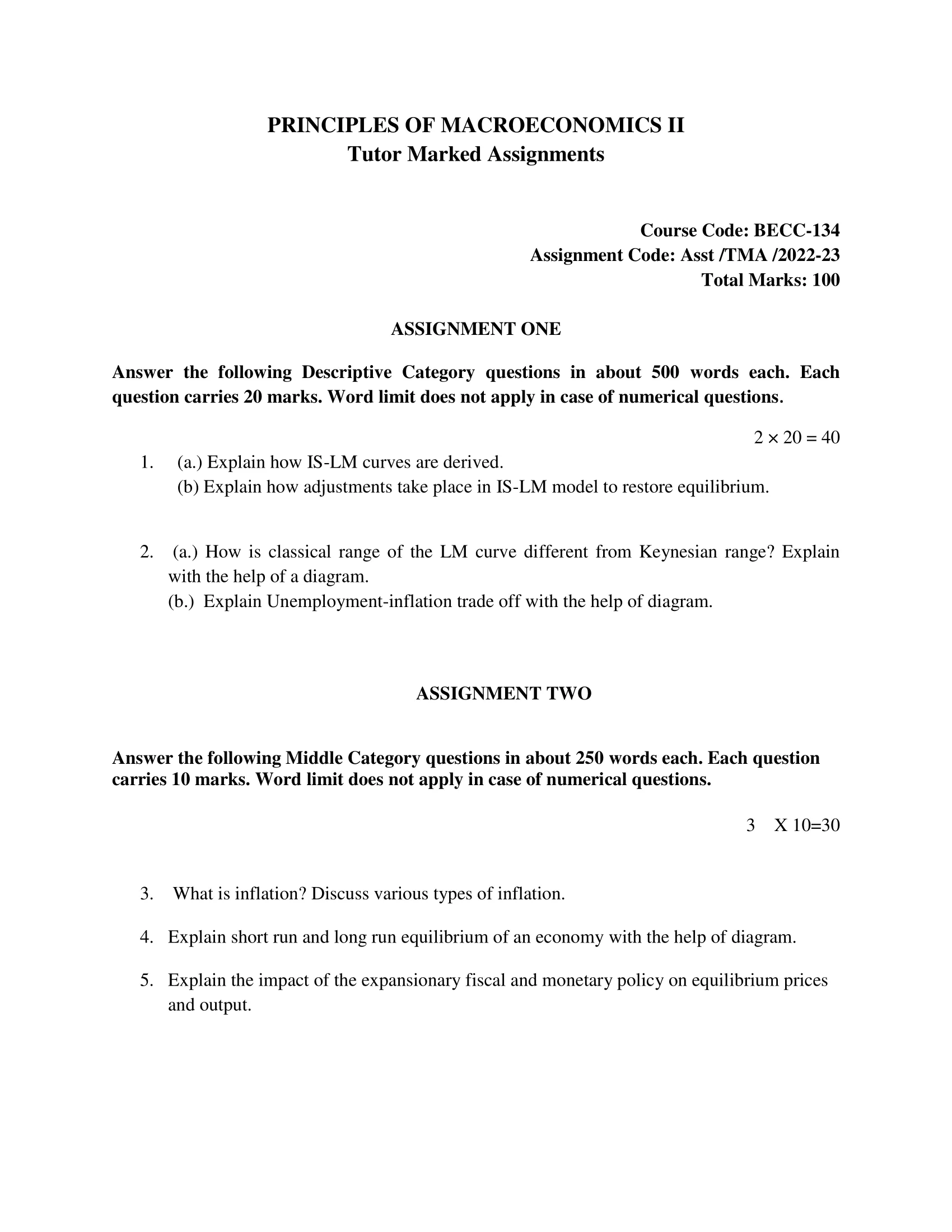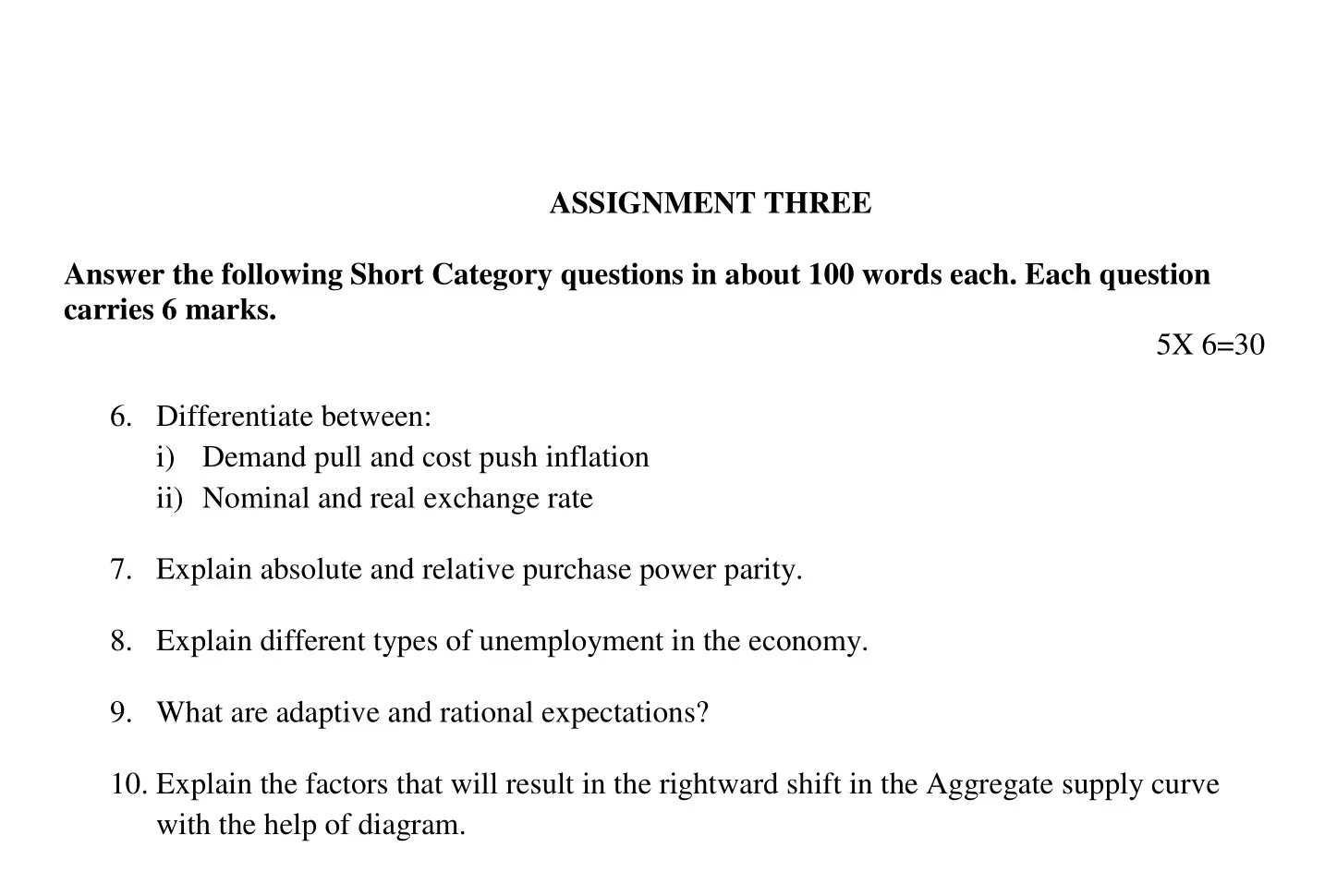
| Title | BECC-134 |
| University | IGNOU |
| Degree | Bachelor Degree Programme |
| Course Code | BECC-134 |
| Course Name | PRINCIPLES OF MACROECONOMICS II |
| Programme Name | Bachelor of Arts (General) |
| Programme Code | BAG |
| Total Marks | 100 |
| Year | 2022-2023 |
| Language | English |
| Assignment Code | Asst /TMA /2022-23 |
| Last Date for Submission of Assignment: | For June Examination: 31st April For December Examination: 30th September |


ASSIGNMENT ONE
Answer the following Descriptive Category questions in about 500 words each. Each question carries 20 marks. Word limit does not apply in case of numerical questions. 2 × 20 = 40
1. (a.) Explain how IS-LM curves are derived.
Ans: The IS-LM (Investment-Saving-Liquidity-Money) model is a macroeconomic model that explains the interaction between the goods and financial markets in the economy. The IS-LM model graphically depicts the equilibrium in the goods market and the financial market.
The IS (Investment-Saving) curve represents the relationship between the interest rate and aggregate output (real GDP) in the goods market. The IS curve slopes downwards, indicating that as the interest rate decreases, investment increases and therefore, aggregate output increases. The IS curve is derived by considering the investment demand and the saving supply. The investment demand is influenced by the interest rate as well as other factors such as tax policies and expectations of future economic growth.
The LM (Liquidity-Money) curve represents the relationship between the interest rate and the demand for money in the financial market. The LM curve slopes upwards, indicating that as the interest rate increases, the demand for money decreases, and vice versa. The LM curve is derived from the demand for money and the money supply. The demand for money is a function of the interest rate and other factors such as the level of income, expectations of future inflation and wealth.
The intersection of the IS and LM curves represents the equilibrium in the economy, where the goods market and financial market are in balance. The interest rate at the intersection point represents the market-clearing interest rate, and the real GDP at the intersection point represents the equilibrium level of output.
The IS-LM model is a useful tool for analyzing macroeconomic policy changes. For example, a monetary policy that increases the money supply will shift the LM curve to the right, resulting in a lower interest rate and higher real GDP. On the other hand, a fiscal policy that increases government spending will shift the IS curve to the right, also resulting in a lower interest rate and higher real GDP.
(b) Explain how adjustments take place in IS-LM model to restore equilibrium.
Ans: The IS-LM model is a graphical representation of the interactions between the goods market and the financial market in an economy. The IS-LM model depicts the equilibria in the two markets and the adjustment process that takes place to restore equilibrium when one of the markets is disturbed. In this model, the IS curve represents the demand for goods and services, while the LM curve represents the demand for money. When there is a disturbance in one of the markets, the system moves away from the equilibrium, and adjustments take place in both markets to restore the equilibrium.
One of the most common disturbances in the IS-LM model is a change in government spending. An increase in government spending shifts the IS curve to the right, which increases the demand for goods and services and raises the interest rate. This results in a shortage of money in the financial market, and the LM curve shifts to the left to restore the equilibrium. The LM curve shifts leftward because a higher interest rate increases the demand for money, which leads to a rise in the money supply.
Another common disturbance in the IS-LM model is a change in the money supply. An increase in the money supply shifts the LM curve to the right, which reduces the interest rate and raises the demand for goods and services. The increased demand for goods and services shifts the IS curve to the right, which raises the interest rate and reduces the demand for money. The IS curve shifts rightward because a lower interest rate reduces investment, which leads to a decrease in the demand for goods and services.
A change in the price level also affects the IS-LM model. An increase in the price level shifts the LM curve to the right, which reduces the interest rate and raises the demand for goods and services. The increased demand for goods and services shifts the IS curve to the right, which raises the interest rate and reduces the demand for money. The IS curve shifts rightward because a higher price level increases the demand for goods and services, which leads to an increase in investment.
2. (a.) How is classical range of the LM curve different from Keynesian range? Explain with the help of a diagram.
Ans: The LM curve represents the relationship between the interest rate and the demand for money in the financial market in the IS-LM model. The classical range of the LM curve and the Keynesian range of the LM curve differ in terms of the assumptions they make about the money demand and the money supply.
In the classical range of the LM curve, the money demand is inelastic, meaning that the demand for money does not change significantly with changes in the interest rate. This is because the classical economists believe that people hold money as a store of value rather than for transactions purposes. The classical range of the LM curve is shown as a vertical line on the IS-LM diagram.
In the Keynesian range of the LM curve, the money demand is more elastic, meaning that the demand for money changes significantly with changes in the interest rate. This is because Keynesian economists believe that people hold money for transactions purposes and therefore, changes in the interest rate affect the demand for money. The Keynesian range of the LM curve is shown as a downward-sloping line on the IS-LM diagram.
The following diagram illustrates the difference between the classical and Keynesian ranges of the LM curve:
[Insert Diagram Here]
In the diagram, the classical range of the LM curve is shown as a vertical line, which indicates that changes in the interest rate do not affect the demand for money. In contrast, the Keynesian range of the LM curve slopes downwards, indicating that the demand for money changes with changes in the interest rate.
The classical range of the LM curve applies in conditions where the economy is at full employment and there is no excess capacity in the goods market. In such conditions, changes in the interest rate do not affect the demand for goods and services, and the goods market remains in equilibrium. In the Keynesian range of the LM curve, the demand for money changes with changes in the interest rate, and the goods market is not at full employment. In such conditions, changes in the interest rate can affect the demand for goods and services, leading to changes in the output and the level of employment.
(b.) Explain Unemployment-inflation trade off with the help of diagram.
Ans: The relationship between unemployment and inflation is known as the unemployment-inflation trade-off, and it is a central concept in macroeconomics. The trade-off suggests that there is a trade-off between the two variables: increasing unemployment will reduce inflation, and increasing inflation will reduce unemployment. This trade-off is depicted on a Phillips curve, which is a graphical representation of the relationship between the inflation rate and the unemployment rate.
The Phillips curve shows that there is a negative relationship between inflation and unemployment, meaning that as inflation increases, unemployment decreases, and as inflation decreases, unemployment increases. This relationship arises from the idea that there is a trade-off between the two variables because an increase in inflation stimulates demand for goods and services, leading to increased economic activity, higher employment, and lower unemployment.
The following diagram illustrates the relationship between unemployment and inflation on a Phillips curve:
[Insert Diagram Here]
In the diagram, the Phillips curve slopes downward from left to right, indicating that there is a negative relationship between inflation and unemployment. Point A represents a low unemployment rate and a high inflation rate, while Point B represents a high unemployment rate and a low inflation rate. The curve represents the trade-off between the two variables, meaning that policymakers have to choose between a lower inflation rate and a higher unemployment rate or a higher inflation rate and a lower unemployment rate.
The trade-off between unemployment and inflation is not always a linear relationship. The shape of the Phillips curve can change over time due to changes in macroeconomic policies and the state of the economy. For example, during times of high economic growth, the Phillips curve may be flatter, meaning that a given change in inflation will result in a smaller change in unemployment. During times of economic slowdown, the Phillips curve may be steeper, meaning that a given change in inflation will result in a larger change in unemployment.
ASSIGNMENT TWO
Answer the following Middle Category questions in about 250 words each. Each question carries 10 marks. Word limit does not apply in case of numerical questions. 3 X 10=30
3. What is inflation? Discuss various types of inflation.
Ans: Inflation refers to the sustained increase in the general price level of goods and services in an economy over a period of time. It is usually measured by the Consumer Price Index (CPI) or the Producer Price Index (PPI). When the general price level rises, each unit of currency buys fewer goods and services; consequently, inflation reflects a reduction in the purchasing power of money.
There are several types of inflation:
- Demand-pull inflation: This occurs when there is an increase in aggregate demand in an economy, causing prices to rise. This type of inflation is often seen during economic booms.
- Cost-push inflation: This occurs when there is an increase in the cost of production, such as a rise in the cost of raw materials or labor. This type of inflation can lead to a decrease in aggregate supply, causing prices to rise.
- Structural inflation: This occurs when there are changes in the structure of an economy that cause prices to rise. For example, changes in technology or demographics can lead to an increase in the demand for certain goods and services, causing prices to rise.
- Monetary inflation: This occurs when there is an increase in the money supply, causing prices to rise. This type of inflation is often caused by expansionary monetary policies, such as low interest rates or the printing of new money.
It is important to note that moderate inflation is considered healthy for an economy, as it can lead to economic growth and increased investment. However, excessive inflation can have a negative impact on the economy, causing instability and reducing the purchasing power of consumers. Governments and central banks use various monetary and fiscal policies to control inflation and maintain economic stability.
4. Explain short run and long run equilibrium of an economy with the help of diagram.
Ans: Short run and long run equilibrium refer to the state of balance in an economy, where the quantity demanded of goods and services is equal to the quantity supplied. The distinction between short run and long run is based on the time frame being considered and the ability of certain factors to change.
In the short run, some factors of production, such as capital and technology, are fixed, while others, such as labor, can change. This means that the economy can be in a state of disequilibrium in the short run, where there is either a surplus or a shortage of goods and services. The short run equilibrium can be depicted by a supply and demand diagram, where the intersection of the supply and demand curves represents the market price and the quantity at which they are equal.
In the long run, all factors of production are variable, meaning that the economy can adjust to changes in demand and supply, and reach a state of long run equilibrium. This state can be represented by a shift in the supply and demand curves, until a new intersection is reached, showing a new market price and quantity.
It is important to note that in the long run, the supply and demand curves are more elastic, meaning that they respond more readily to changes in the market, leading to a more efficient allocation of resources and a greater stability in the economy. In the short run, however, changes in demand and supply may lead to more volatility and less predictability in the market.
5. Explain the impact of the expansionary fiscal and monetary policy on equilibrium prices and output.
Ans: Expansionary fiscal and monetary policy are government and central bank policies aimed at increasing aggregate demand in the economy, leading to higher economic growth and lower unemployment. These policies have a significant impact on equilibrium prices and output in the economy.
Expansionary fiscal policy refers to an increase in government spending or a decrease in taxes, which increases aggregate demand and stimulates economic activity. This can lead to an increase in the price level and a higher output, as firms respond to increased demand by producing more goods and services.
Expansionary monetary policy, on the other hand, involves an increase in the money supply, which lowers interest rates and encourages investment and consumption. This leads to an increase in aggregate demand, which can drive up prices and output, as firms respond to increased demand by producing more goods and services.
However, it is important to note that excessive expansionary fiscal and monetary policy can lead to inflation, as the increase in aggregate demand outpaces the growth in aggregate supply, leading to upward pressure on prices. In addition, excessive expansionary policy can lead to an overheating of the economy, causing a rapid increase in prices, output, and economic activity, which can ultimately lead to a recession.
ASSIGNMENT THREE
Answer the following Short Category questions in about 100 words each. Each question carries 6 marks. 5X 6=30
6. Differentiate between:
i) Demand pull and cost push inflation
Ans: Demand pull inflation and cost push inflation are two different types of inflation that occur in an economy.
Demand pull inflation occurs when aggregate demand in the economy exceeds aggregate supply, causing prices to rise. This can be the result of an increase in consumer spending, investment, or government spending, which drives up demand for goods and services.
Cost push inflation, on the other hand, occurs when the cost of production increases, causing firms to raise prices to maintain their profit margins. This can be the result of a rise in the cost of raw materials, labor, or energy, which leads to a decrease in aggregate supply, and an increase in prices.
In summary, demand pull inflation is driven by an increase in demand, while cost push inflation is driven by an increase in costs. Both types of inflation can lead to an increase in the general price level, reducing the purchasing power of money, but they have different causes and policy implications.
ii) Nominal and real exchange rate
Ans: The nominal exchange rate and the real exchange rate are two different measures of the value of a currency in relation to another currency.
The nominal exchange rate is the rate at which a currency can be exchanged for another currency, without adjusting for inflation. It is the market-determined exchange rate, based on supply and demand for currencies in the foreign exchange market.
The real exchange rate, on the other hand, adjusts the nominal exchange rate for differences in inflation between two countries. It measures the purchasing power of a currency relative to another currency, and reflects the ability of a currency to buy goods and services in another country, after accounting for differences in inflation.
7. Explain absolute and relative purchase power parity.
Ans: Absolute and relative purchase power parity (PPP) are two different approaches to measuring the value of a currency in terms of its purchasing power.
Absolute PPP holds that the exchange rate between two currencies should equal the ratio of the prices of a basket of goods and services in each country. In other words, it holds that the same goods should cost the same in different countries, when prices are converted into a common currency.
Relative PPP, on the other hand, holds that the rate of inflation in one country should equal the rate of appreciation or depreciation of its currency relative to another currency. In other words, it holds that the difference in inflation between two countries should be reflected in the exchange rate between their currencies.
8. Explain different types of unemployment in the economy.
Ans: There are several different types of unemployment that exist in an economy. These types include:
- Frictional unemployment: This occurs when individuals are in between jobs and are searching for new employment opportunities. This type of unemployment is considered normal and occurs as part of the natural process of workers moving between jobs.
- Structural unemployment: This occurs when there is a mismatch between the skills and qualifications of workers and the requirements of available jobs. This type of unemployment occurs when changes in technology or the economy result in the displacement of workers who are no longer able to find work in their field.
- Cyclical unemployment: This occurs when there is not enough demand for goods and services in the economy, leading to reduced production and layoffs. This type of unemployment is a result of the business cycle and occurs during economic recessions.
- Seasonal unemployment: This occurs when there is a reduction in employment in certain industries during specific times of the year, such as agriculture or tourism.
- Underemployment: This occurs when individuals are employed but are not working in jobs that fully utilize their skills and abilities. This type of unemployment can occur when workers are employed in part-time or low-paying jobs but would prefer full-time or higher-paying employment.
Understanding the different types of unemployment is important for analyzing the health of the economy and for designing policies to address unemployment.
9. What are adaptive and rational expectations?
Ans: Adaptive expectations and rational expectations are two theories of expectations formation that explain how individuals form expectations about the future.
Adaptive expectations is a theory that states that individuals form expectations based on their past experiences. In this theory, individuals adjust their expectations gradually based on past events and their experiences. For example, if an individual experiences inflation, they may expect inflation to continue in the future and adjust their expectations accordingly.
Rational expectations is a theory that states that individuals form expectations based on all available information. In this theory, individuals use their knowledge and understanding of the economy to form expectations about the future. For example, if an individual has information about a new economic policy that is expected to increase growth, they may form expectations about higher future economic growth.
Both theories suggest that expectations play a critical role in the determination of economic outcomes. However, they differ in their assumptions about the way in which individuals form expectations. Adaptive expectations assumes that individuals form expectations based on past experiences, while rational expectations assumes that individuals form expectations based on all available information.
10. Explain the factors that will result in the rightward shift in the Aggregate supply curve with the help of diagram.
Ans: The aggregate supply curve shows the relationship between the price level and the quantity of goods and services produced in an economy. A rightward shift in the aggregate supply curve represents an increase in the quantity of goods and services produced in the economy for a given price level. There are several factors that can result in a rightward shift in the aggregate supply curve. These factors include:
- Increased input prices: An increase in the prices of factors of production, such as labor, capital, and raw materials, can result in a rightward shift in the aggregate supply curve.
- Technological improvements: Advances in technology can increase productivity and reduce the cost of production, leading to a rightward shift in the aggregate supply curve.
- Increased foreign trade: An increase in foreign trade can increase the availability of inputs, leading to a rightward shift in the aggregate supply curve.
The following diagram illustrates the rightward shift in the aggregate supply curve:
[Insert Diagram Here]
In the diagram, the original aggregate supply curve is represented by AS1, and the rightward shift in the aggregate supply curve is represented by AS2. The shift from AS1 to AS2 represents an increase in the quantity of goods and services produced in the economy for a given price level.
How to Download BECC-134 2022-2023 (PRINCIPLES OF MACROECONOMICS II) Solved Assignment?
You can download it from the www.edukar.in, they have a big database for all the IGNOU solved assignments.
Is the BECC-134 2022-2023 (PRINCIPLES OF MACROECONOMICS II) Solved Assignment Free?
Yes this is absolutely free to download the solved assignment from www.edukar.in
What is the last submission date for (IGNOU-BAG) Solved Assignment?
For June Examination: 31st April, For December Examination: 30th October
